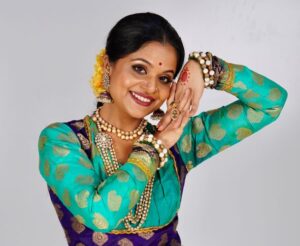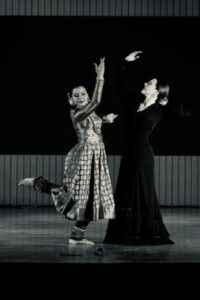From Seoul to Soul with Aditi Bhagwat

She is called one of the brightest stars in the world of Lavni, she has received her Masters in Psychology and Masters in Dance from the Gandharva Mahavidyalaya. She is also the recipient of the title of Nalanda Nritya Nipun.
I spoke with the enormously talented Aditi Bhagwat who is back after performing at the prestigious Duo Dance Festival in Seoul, Korea. She believes that international collaborations have only taught her to be more accepting and respectful of cultures all of the world. Working with other disciplines of music has made her step out of her comfort zone and explore the unknown. Excerpts from the interview:
Tell me more about your dance training and your teachers?
I started training at the age of four years under Padma Shri Dr Roshan Kumariji in the Jaipur Gharana of Kathak with strict discipline and decorum. Later, I also received able guidance from one of her senior most disciples Nandita Puri. I have trained with Jhelum Paranjape in Odissi for nearly a decade and continue to train in Taal and rhythmic structures with the Tabla Maestro Guru Yogesh Samsi. I have imbibed all the knowledge I received while working with eminent musicians like Louiz Banks, Ravi Chary, Viveick Rajagopalan, Sivamani, Merlin Dsouza in my stage performances and creative projects.
You initially chose Kathak, but later moved towards Lavni…
My mother Ragini Bhagwat was a trained classical vocalist and a stage performer. She was known for her versatility as a singer and I always heard her singing Ghazals, Bhajans, Thumris and even popular folk and film music from various different Indian languages. She was very keen that I learn Kathak, I was obviously too little to make any important choices or decisions but we had a friend who was learning Kathak from Roshan ji and I seemed to enjoy watching her dance and practice hence it was confirmed that Kathak was for me. I heard my mom render, compose and write Lavanis and we had a culture of music and dance at home because of her. She would often take me along to watch Lavani performances by eminent artists. Being a Maharashtrian myself, I understood the poetry and literature well enough to emote and express it. Having trained in Kathak for nearly three decades helps me understand and perform the rhythms of the Dholki better. Dholki maestro par excellence Anant Panchal was responsible for broadening my vision of the Lavani and Dholki. He would compose Dholki dance segments in odd cycles and beats like 9 or 7 beats and I enjoyed dancing to these challenging compositions wholeheartedly.
Many consider Lavni to be not a very classy dance what is your reply to them?
There is really a very thin line between sensuality, glamour and vulgarity. The line can be crossed in any dance form. It is up to the artist to maintain elegance, grace and still cater to the masses and classes. Lavani, per say is a rich art form that one can study with a lot of detail and depth. The literature it offers is vast and Lavani is an art form not just meant for entertainment but was a medium of social reformation during the freedom struggle and continues to address vices in the society even till date. Lavanis discuss social issues like casteism, dowry, alcoholism, domestic violence, inequality and so many such issues. Some Lavanis written by the saints in Maharashtra spoke of worship, devotion towards Sri Krsna and liberation – Moksha.
Tell us about your collaborations with international artists.
One of my best collaborative experiences was when I was on a fellowship program titled OneBeat by the US State Department of Educational and Cultural Affairs. I was in a residency with 30 other musicians from all over the world and we studied each other’s music. I was enriched as I worked with some phenomenal artists playing the Gayageum, Cuatro, Oud, Banjo, Dulcimer. I participated as a foot percussionist using my Ghungroos as my instrument. I collaborated with Flamenco exponent Bettina Castaño on our projects Crossroads and Colours of Spain with Spanish Pianist Almudena Longares. I also worked on a Gypsy- Jazz music project with the Hungarian Jazz pianist and composer Bela Szakcsi Lakatos. It was my honour to present Kathak in a project of this kind, the music was unique and the audience completely new to my medium of expression. American Jazz artists like Flautist and Saxophonist Dallas Smith and Jazz Harpist Susan Mazer, American Tap dancer Sam Weber have added to my knowledge of collaborative music and it has been a learning journey with them. Collaborating with musicians like Yotam Agam from the Electronic genre of music during a tour in France was a one of a kind experience too.
Your recent trip to Korea was a great way to bring the two cultures together. Tell us more about that.
I call it From Seoul to Soul. I performed at the Duo Dance Festival in Seoul and my Korean student and an able Kathak dancer in her own right, Noori Bak performed with me. I performed a composition I wrote for one of my Tedx Talks. It is an Ode to dance- narrating every experience of it, what dance brings to my life and how eventually that dance becomes me.
What is next on your plate?
Next up is my project Laya Ki Kahani- The story of time. It is a Kathak based project with Mridangam artist and composer Viveick Rajagopalan. The project showcases complex Laya (tempo or pace in dance) patterns and traditional rhythms along with contemporary narratives combining stories from every day like and dance movements and syllables. I also am busy with my dance academy and a couple of international tours that will be slated this year.
Sandip Soparrkar holds a doctorate in world mythology folklore from Pacific University USA, an honorary doctorate in performing arts from the National American University, He is a World Book Record holder, a well-known Ballroom dancer and a Bollywood choreographer who has been honored with three National Excellence awards, one National Achievement Award and Dada Saheb Phalke award by the Government of India. He can be contacted on sandipsoparrkar06@gmail.com






